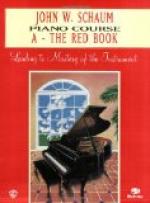The question of lifting the fingers seems to be one on which various opinions are held. Some pianists, like Godowsky for instance, will tell you they do not approve of raising the fingers—that the fingers must be kept close to the keys. It is noticeable, however, that even those who do not speak favorably of finger action, use it themselves when playing passages requiring distinctness and clearness. Other players are rather hazy on the subject, but these are generally persons who have not gone through the routine of teaching.
The accepted idea of the best teachers is that at the beginning of piano study positive finger movements must be acquired; finger action must be so thoroughly grounded that it becomes second nature, a very part of the player, something he can never forget nor get away from. So fixed should it become that no subsequent laxity, caused by the attention being wholly centered on interpretation can disturb correct position, condition, or graceful, plastic movement.
“For passage work I insist on finger action; the fingers must be raised and active to insure proper development. I think one certainly needs higher action when practising technic and technical pieces than one would use when playing the same pieces before an audience.”—Clarence Adler.
Alexander Lambert speaks to the point when he says: “I teach decided finger action in the beginning. Some teachers may not teach finger action because they say artists do not use it. But the artist, if questioned, would tell you he had to acquire finger action in the beginning. There are so many stages in piano playing. The beginner must raise his fingers in order to acquire finger development and a clear touch. In the middle stage he has secured enough finger control to play the same passages with less action, yet still with sufficient clearness, while in the more or less finished stages the passage may be played with scarcely any perceptible motion, so thoroughly do the fingers respond to every mental requirement.”
It is this consummate mastery and control of condition and movement that lead the superficial observer to imagine that the great artist gives no thought to such things as position, condition and movements. Never was there a greater mistake. The finest perfection of technic has been acquired with painstaking care, with minute attention to exacting detail. At some period of his career, the artist has had to come down to foundation principles and work up. Opinions may differ as to the eminence of Leschetizky as a teacher, but the fact remains that many of the pianists now before the public have been with him at one time or another. They all testify that the Viennese master will have nothing to do with a player until he has gone through a course of rigorous preparation spent solely in finger training, and can play a pair of Czerny etudes with perfect control and effect.




